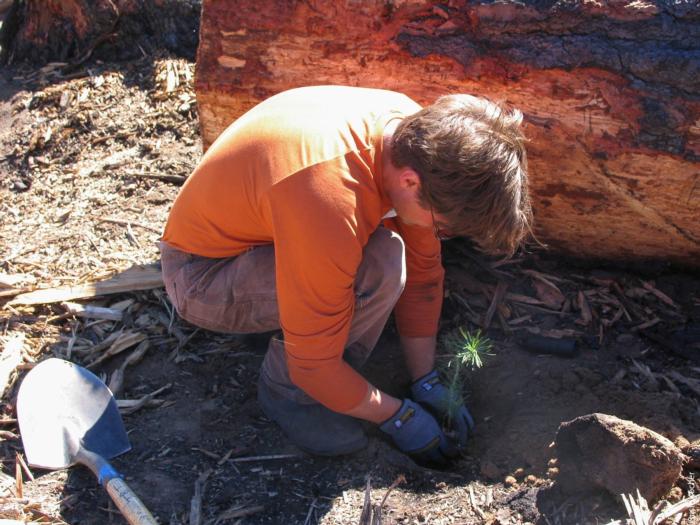Reforestation
|
Restoring your forest and woodland is critical to ensuring the ongoing health of your land. After wildfire, vegetation plays an important role in preventing erosion, producing clean water, and maintaining wildlife habitat. Re-establishing native vegetation also helps control invasive species. |
|
When Should I Plant?
Seedlings are typically planted between December-April. Work with your forester or local nursery to identify the best planting time for your particular seedling stock and region. Failure to do so lead to post-planting problems, such as drought and transplant shock. The sooner seedlings are planted, the sooner root growth starts and the plants can begin adjusting to their new environment. Never plant in frozen ground or during freezing temperatures as this will cause the fine root hairs to freeze. More information on planting technique may be found here.
Preparing to Plant
Site preparation is necessary to accelerate the recovery of an area into forest. After high severity forest fire, shrubs are typically the first to reoccupy a site, quickly taking up the available light and suppressing growth of surrounding trees with its shade. This forms a consistent and flammable fuel bed with increased risk of ignition compared to forests.
Under natural conditions, trees eventually grow above the shrub and over several generations, re-establish into a forest. Today, with the combined impact of ongoing fire suppression and drier climates, many areas are unable to recover a forest structure before experiencing another high severity wildfire event.
Preparing your site in advance of reforestation efforts accelerates the growth of trees;
- Accelerating the establishment of forests
- Suppress the introduction of invasive species
- Minimize risk of fire
- Reduce erosion potential
Click here for guidance on restoring home landscapes
Finding Trees
Finding seedlings can be difficult in the aftermath of wildfire. Nursery seedlings require up to one year to grow before they are ready to plant. While seed may also be used directly, they have much lower rates of success due to predation from wildlife and exposure to weather. Due to the unpredictability of wildfire, seedlings are not always available immediately.
The LA Moran Reforestation Center currently collects and stores seed from across California for private landowner use. They occasionally work with local nurseries to grow seedlings in anticipation of a reforestation need. Due to the unpredictability of fire, there may not always be local seed appropriate to your property.
During the Fall, many nurseries will accept orders for planting the following Spring. Consult with your local Resource Conservation District, Registered Professional Forester, or Extension Forester to learn more about placing an order to reforest your land.
References
- Kocher (2018), What to Replant After the Trees Die, UC Cooperative Extension
- McCreary, (2004) Fire in California's Oak Woodlands, UC Cooperative Extension
- Anstedt, (2011) Evaluating the Effects and Effectiveness of Post-fire Seeding Treatments in Western Forests, University of Nebraska-Lincoln
- Hufford, Reseeding After Fire: If, When, and How, University of Wyoming
- Bray and Heissenbuttel, (2015) Rebuilding a Green Landscape After Wildfire, UCCE Master Gardeners
- Barkley, Reforesting Your Forestland after a Wildfire, University of Idaho Extension
- McCreary, (2009) Regenerating Rangeland Oaks in California, UC Agriculture and Natural Resources
- Griffis, Seed Zone Map, LA Moran Reforestation Center
